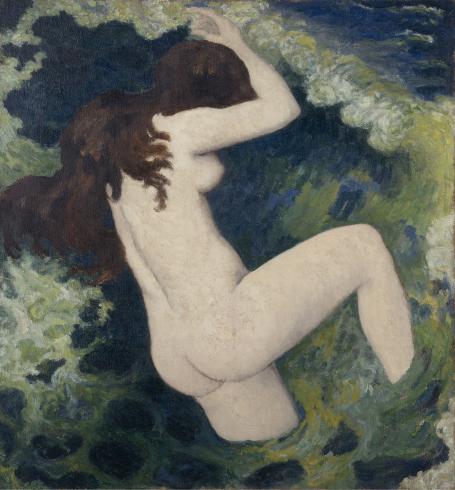In a letter to his countryman Bourdelle, who introduced him to sculpture, Maillol describes the pleasure he takes in watching the waves: “I do studies of the sea.It feels strange painting the sea, you never know what colour it is.” So when he decided to paint a nude, Maillol naturally made her a bather.
The composition follows a horizonless spatial schema that follows the pattern of the decorative spirals that are a legacy of Japanism. The curves of the wave whose foam envelops the bather reflect the waves in her hair. This fusional representation of the bather and the marine element evokes the very sensual Woman in the Wave (1868, New York, The Metropolitan Museum of Art) by Gustave Courbet, whose pictorial power Maillol admired.
The harmonious curves of the nude treated in a global manner fit neatly into the nearly square format of the canvas, like a metope in a Greek temple. The choice of matt paint is also a reference to architecture and more precisely mural painting, an area where Puvis de Chavannes was the great moderniser at the time.
The timeline of the pictures painted by Maillol before 1900 remains hard to establish. With its architectural relationship of the body to space, the clarity of its contours and the fullness of its forms, The Wave ushered in the great sculptures of female nudes to which Maillol would devote himself from the turn of the 20th century onwards.
I. C.

City of Paris municipal collection's website
The collections portal can be used to search the collections of Paris’s 14 municipal museums (approximately 336,000 works, including 43,000 belonging to the Petit Palais).
It is also possible to download around 12,000 images of the museum’s works free of charge.
Access the Museums of the City of Paris collections portal
Extern databases
Discover a selection of databases online presenting works from the Petit Palais or documents concerning the history of the museum.

